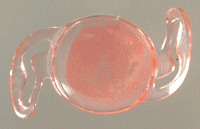Researchers define two types of IOL calcification
Primary calcification is inherent in the IOL itself, whereas secondary may stem from environmental circumstances within the eye, study authors said.
 David J. Apple |
After nearly a decade of studying the incidence and pathogenesis of various types of IOL calcification, a team of ophthalmologists has defined two clinically significant ways by which lenses can become calcified.
David J. Apple, MD, and colleagues at the Moran Eye Center in the United States have examined several hundred explanted calcified IOLs, many of which were hydrophilic acrylic designs. They have identified two types of calcification, which they term primary and secondary, of which ophthalmologists must be aware.
“When evaluating the pathogenesis and nature of IOL calcification with any given design, one should categorize it according to these types,” the authors wrote in the study, which has appeared online in Ophthalmology.
Types of calcification
According to Dr. Apple, primary calcification is inherent in the IOL itself. It may stem from the inadequate formulation of the polymer, a problem in the fabrication process or issues with the packaging. Primary calcification generally occurs in healthy eyes without pre-existing disease, he said.
“Basically, the lens is defective. For example, it was poorly fabricated or had inappropriate polymers in its recipe,” Dr. Apple said in an interview with Ocular Surgery News.
In most cases of primary calcification, the granules penetrate into the lens material or substance, usually involving the optic but sometimes both the optic and haptic components, he said.
“Such IOLs should be withdrawn or modified to correct the problem. Many have already been removed from the market. After the cause is identified and the problem is thought to be corrected, the patients should be followed up for 2 years to be sure the problem is alleviated,” the authors wrote.
In contrast, secondary calcification refers to calcium deposits on the IOL surface, most likely stemming from environmental causes, such as changes in the aqueous milieu associated with a pre-existing condition.
“With secondary calcification, the lens is not at fault. Any disease that causes a breakdown of the blood-aqueous barrier may cause this problem,” Dr. Apple said. “Most involved lenses are porous hydrophilic acrylic lenses, thus enhancing the deposit of abnormal aqueous components, eg, proteins, cells and minerals, on the surface of the optical component.”
Well-known conditions that can lead to secondary calcification include diabetic oculopathy, persistent hyperplastic primary vitreous and toxic anterior segment syndrome, Dr. Apple said. Intraoperative mistakes, such as a broken capsule, can also result in secondary calcification.
|
|
Images: Apple DJ |
Vigilance needed
The issue of IOL calcification took center stage beginning in the late 1990s, when several popular hydrophilic acrylic lenses — such as the Hydroview (Bausch & Lomb), MemoryLens (CIBA Vision), SC60B-OUV (MDR) and Aqua-Sense (Ophthalmic Innovations International) — were found to develop primary calcifications in some cases.
Lens makers have addressed these issues, and since then, questionable IOLs have largely been removed. Most importantly, two models of hydrophilic acrylic IOL — Akreos (Bausch & Lomb) and Centreflex (Rayner) — have gone on to be implanted hundreds of thousands of times without any primary calcification, Dr. Apple said.
“I was pleased when I noted that these two lenses passed the test without primary calcification. I thought they were great,” he said. “But then we saw a few cases of secondary calcification — no fault of the lens — but because they happened to be in diseased eyes or eyes with other conditions such as surgical trauma. So we’re not over the bridge, we’re not 100% safe. Surgeons need to know that this exists, so if one of these lenses shows a late stage of secondary opacification, they will know what it is.
“Doctors can never be totally free of concern with these lenses. We’ve seen secondary calcification up to 2 years or more,” Dr. Apple said.
For more information:
- David J. Apple, MD, can be reached at the John A. Moran Eye Center, 65 N. Medical Drive, Salt Lake City, UT 84132 U.S.A.; +1-801-213-2167; e-mail: djapple@comcast.net. Dr. Apple has no direct financial interest in the products discussed in this article, nor is he a paid consultant for any companies mentioned.
Reference:
- Neuhann IM, Kleinmann G, Apple DJ. A new classification of calcification of intraocular lenses. Ophthalmology. May 9, 2007; [Epub ahead of print].
- Andy Moskowitz is an OSN Staff Writer who covers all aspects of ophthalmology.


